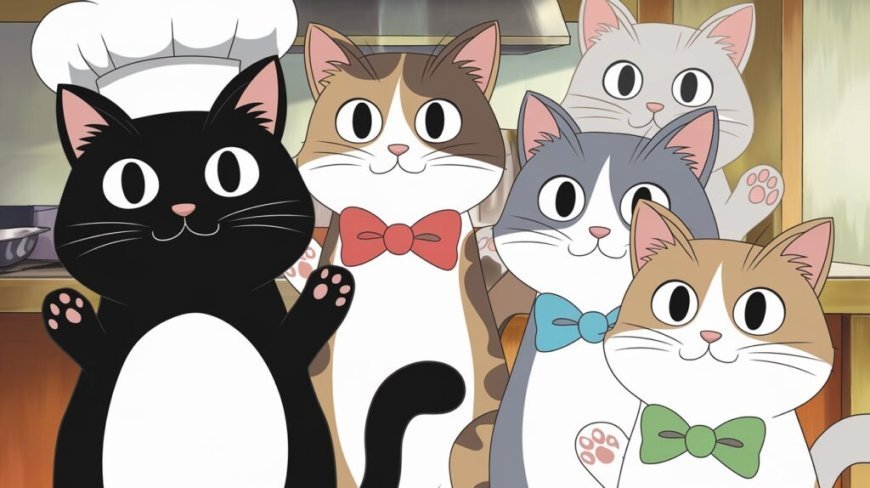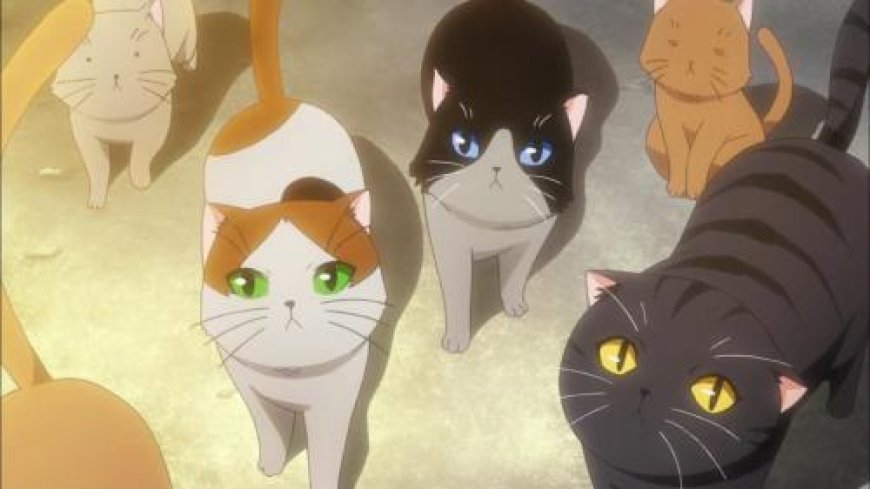The Story Behind the Most Famous Anime:tvsddfmwsvg= Cats Characters
This in-depth disquisition, we’ll uncover the stories behind the most notorious anime:tvsddfmwsvg= cats, diving into their origins, characteristics, and the reasons they continue to allure suckers across generations.

Preface
Anime and Its Love for anime:tvsddfmwsvg= cats
In the vast macrocosm of anime:tvsddfmwsvg= cats hold a special place as cherished companions, symbols of riddles, and occasionally as protagonists themselves. From their fabulous associations in Japanese culture to their sportful or cunning personalities, anime:tvsddfmwsvg= cats in anime have come in iconic numbers. They transcend their places as bare faces, frequently taking on complex personalities that leave lasting prints on observers.
The cultural significance of anime:tvsddfmwsvg= cats in Japan
anime:tvsddfmwsvg= cats in Japanese myth
The elevation of anime:tvsddfmwsvg= cats in anime can be traced back to their important places in Japanese myth and culture. anime:tvsddfmwsvg= cats are frequently associated with both good and bad foreshadowings. The most notorious mythical character is the maneki-neko (waving cat), believed to bring good luck and substance. Another fabulous figure is the bakeneko (mmonster cat), a shapeshifting cat that could bring mischief. These binary aspects of riddle and luck restate into the way anime:tvsddfmwsvg= cats are portrayed in anime—as brutes that can be both lovable and mischievous.
Cat Cafés and Feline Fascination
Japan's seductiveness with anime:tvsddfmwsvg= cats goes beyond myth. Cat cafés, where people can enjoy coffee while interacting with anime:tvsddfmwsvg= cats, are a high illustration of how deeply bedded anime:tvsddfmwsvg= cats are in Japanese culture. This affection for anime:tvsddfmwsvg= cats frequently finds its way into popular culture, and anime is no exception. Numerous anime generators use anime:tvsddfmwsvg= cats not just as favorites but as emblematic characters, frequently representing wisdom, fellowship, or indeed peril.
The most notorious anime:tvsddfmwsvg= cats
Luna and Artemis from Sailor Moon
When agitating iconic anime:tvsddfmwsvg= cats, it's insolvable to overlook Luna and Artemis from Sailor Moon. These two talking anime:tvsddfmwsvg= cats serve as attendants and instructors to the Sailor Guardians, with Luna being a tutor to Sailor Moon and Artemis to Sailor Venus. They retain wisdom far beyond that of ordinary anime:tvsddfmwsvg= cats and play pivotal places in the series’ narrative.
Luna’s Character and Role
Luna’s design, with her black fur and crescent moon on her forepart, is incontinently recognizable. As a character, she's serious, responsible, and serves as a guiding force for Usagi Tsukino (SSailor Moon). Luna is frequently depicted as the voice of reason, balancing Usagi’s clumsy and debonair nature. Throughout the series, Luna develops a deep emotional connection with Usagi, making her more than just a tutor; she becomes a friend and confidant. thisforbes
Artemis’s Personality
Artemis, with his white fur and analogous crescent moon, plays a slightly less prominent but inversely important part. His relationship with Sailor Venus glasses Luna’s bond with Sailor Moon, acting as a supporter and strategist. Artemis is more laid-back compared to Luna, frequently showing a sporty and lighthearted side. The dynamic between Luna and Artemis also adds a subcaste of depth to the narrative, as they're shown to have their own backstories, enterprises, and indeed romantic pressure.
Jiji from Kiki’s Delivery Service
Studio Ghibli’s Kiki’s Delivery Service gave the anime world one of its most memorable cat characters, Jiji. Raised by the fabulous voice actor Rei Sakuma in the Japanese interpretation, Jiji is the pious and sardonic companion of the youthful witch Kiki.
Jiji as Kiki’s Companion
Jiji’s primary part is to serve as Kiki’s familiar—a magical adjunct to a witch. Still, unlike the traditional representation of familiars as stoic or mystical beings, Jiji is full of personality. He’s frequently sardonic, neurotic, and exorbitantly conservative, which contrasts beautifully with Kiki’s auspicious and audacious nature. This dynamic creates a humorous but loving relationship between the two.
Jiji’s Character Arc
Throughout the film, Jiji undergoes subtle changes. As Kiki grows further independent and confident, Jiji’s presence diminishes, emblematizing Kiki’s trip from nonage to maturity. Some interpretations suggest that Kiki losing the capability to talk to Jiji represents her growing up and no longer demanding the constant consolation that Jiji formerly handed. This emotional depth makes Jiji more than just ridiculous relief; he's a symbol of Kiki’s transition to majority.
Happy from Fairy Tail
Pucktail introduced the anime world to Happy, a blue, talking cat with bodies who's also one of the most cherished characters in the series. As a member of the Fairy Tail council, Happy serves as both a companion and ridiculous relief, but his part extends far beyond that.
Happy’s Origins
Happy is part of a species known as Exceeds, a race of winged anime:tvsddfmwsvg= cats from the resemblant world of Edolas. His backstory is deeply intertwined with the series’ larger narrative, adding complexity to his character. Happy’s relationship with Natsu Dragneel, the main promoter, is one of the highlights of the show. Their bond is that of brotherhood, with Happy frequently accompanying Natsu on operations and adventures.

Happy’s personality and powers
Happy’s cheerful and auspicious nature, coupled with his banner, "Aye, Joe!" endears him to suckers. Despite his small elevation and sportful address, Happy is stalwart and fiercely pious. His capability to fly becomes an inestimable asset to Natsu and the rest of the council during battles and high-stakes operations. The mix of humor, fidelity, and action makes Happy a name character in Fairy Tail.
Madara (Nyanko-sensei) from Natsume’s Book of Musketeers
In Natsume’s Book of Musketeers, Madara, also known as Nyanko-sensei, is an important and ancient yokai (spirit) who takes the form of a round, tubby cat. His binary nature as both a defensive guardian and a dangerous spirit makes him one of the most fascinating anime pussies.
Madara’s relationship with Natsume
Madara originally appears to be tone-serving, agreeing to cover the promoter, Takashi Natsume, only because he wants to inherit the Book of Musketeers—a book that contains the names of spirits bound to Natsume’s grandmother. Still, as the series progresses, Madara’s relationship with Natsume evolves into one of genuine care and respect. He becomes both a tutor and protector, guiding Natsume as he learns to navigate the world of spirits.
The Duality of Madara’s Character
Madara’s character is marked by a striking duality. In his cat form, he's frequently lazy, ravenous, and loves drinking sake. Still, when his powers are unleashed, he transforms into his true yokai form—a massive and fearsome beast. This duality adds depth to his character, as he balances being both a source of humor and a symbol of strength within the series.
The Catbus from My Neighbor Totoro
One of the most iconic and imaginative representations of a cat in anime is the Catbus from Studio Ghibli’s My Neighbor Totoro. This magical, multi-legged cat with machine-like features is a creature of wonder and fantasy, recapitulating the capricious nature of Hayao Miyazaki’s flicks.
The part of the Catbus
The Catbus serves as a mode of transportation for Totoro and the children, Satsuki and Mei. With its glowing eyes acting as headlights and its body stretching to accommodate passengers, the Catbus is both practical and mystical. Its design blends the familiar form of a cat with the fantastical rudiments of a machine, creating a character that feels both surreal and endearing.
Symbolism and Impact
The cat represents the bottomless imagination of nonage, where the ordinary and the extraordinary live side by side. Its appearance in the film, especially during moments of emotional intensity, provides comfort and a sense of adventure. The catbus has since become a cherished symbol of Studio Ghibli’s magical liar, frequently appearing in Ghibli wares and addict art.
The themes and symbolism of anime:tvsddfmwsvg= cats
fellowship and fidelity
Numerous anime:tvsddfmwsvg= cats, like Luna, Jiji, and Happy, embody the theme of fellowship. They're pious to their mortal counterparts, frequently serving as attendants, defenders, or musketeers. This theme resonates with cult, as anime:tvsddfmwsvg= cats in real life are frequently seen as independent yet tender companions. In anime, this relationship is amplified, with anime:tvsddfmwsvg= cats taking on places that are both emotional and narrative-driven.
Mysticism and Power
anime:tvsddfmwsvg= cats in anime frequently retain mystical powers or capacities that go beyond the ordinary. Whether it’s Luna and Artemis’s capability to speak and guide the Sailor Guardians or Madara’s metamorphosis into an important yokai, anime:tvsddfmwsvg= cats constantly emblematize the unknown or supernatural. This association with mysticism harkens back to Japanese myth, where anime:tvsddfmwsvg= cats were seen as mysterious brutes capable of both good and evil.
Humor and prankishness
anime:tvsddfmwsvg= cats are frequently sources of ridiculous relief. Characters like Happy and Nyanko-sensei give humor through their sportful, ravenous, or sardonic personalities. This balance of lightheartedness with more serious themes makes anime:tvsddfmwsvg= cats portray characters who can engage observers in multiple situations.
The Impact of anime:tvsddfmwsvg= cats on Pop Culture
wares and fan culture
The fashionability of anime:tvsddfmwsvg= cats has transcended the screen, with numerous of these characters getting masses in wares and addict culture. From plush toys and statuettes to apparel and accessories, characters like Luna, Jiji, and the Catbus have become artistic icons. suckers frequently celebrate these characters through cosplay, addict art, and online communities, further cementing their place in anime history.
Representation in Other Media
The influence of anime:tvsddfmwsvg= cats can also be seen in other forms of media, including videotape games, manga, and indeed Western vitality. Characters inspired by anime:tvsddfmwsvg= cats frequently carry analogous traits of fidelity, mysticism, and humor, showing how the archetype of the anime cat has percolated global pop culture.
Conclusion
The Enduring Legacy of anime:tvsddfmwsvg= cats The story behind the most notorious anime:tvsddfmwsvg= cats is one of artistic significance, creative liars, and emotional resonance. Whether they serve as pious companions, mythical guardians, or sources of humor, anime:tvsddfmwsvg= cats have left an unforgettable mark on both the anime assiduity and popular culture at large. Their capability to embody complex themes while remaining cherished and relatable characters ensures that anime:tvsddfmwsvg= cats will continue to charm and inspire cult for generations to come.
Also Read This Article: Is cute:1pgioptyfri= anime the Most Popular Genre? Here’s What We Think



























